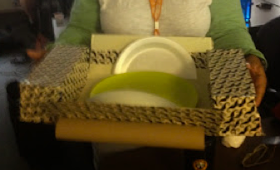The University of Tennessee Health Science Center Masters of
Occupational Therapy students recently completed a number of awesome media projects!
For the assignment, each student was given the name of a common household item. They were instructed to design a creative, appropriate therapy activity for a patient with a specific diagnosis. They did an amazing job! This first media project was submitted by Zann. Her common house hold item was a cereal box!
Assistive Device:
o
A weighted food tray with attachable scoop
plates on the sides so that the patient will be able to scoop food that he
cannot pick up the conventional way.
Use:
o
This will be used to assist patients in
eating food during the early stages of his recovery. This scoop plate tray provides a larger surface area to scoop food
upwards. The tray is also weighted for patients who are unable to
stabilize the plate.
Materials used:
o
Large size cereal box
o
Rocks (or any other heavy material)
o
Velcro
o
Paper towel roll (empty)
o
Plates
o
Duck tape (optional: if patient desires)
This device can be easily decorated to fit the client’s
interest with duck tape or contact paper!
The project above was completed by one of our Master's of
Occupational Therapy students at
The University of Tennessee Health Science Center and posted with permission.
The University of Tennessee Health Science Center and posted with permission.




